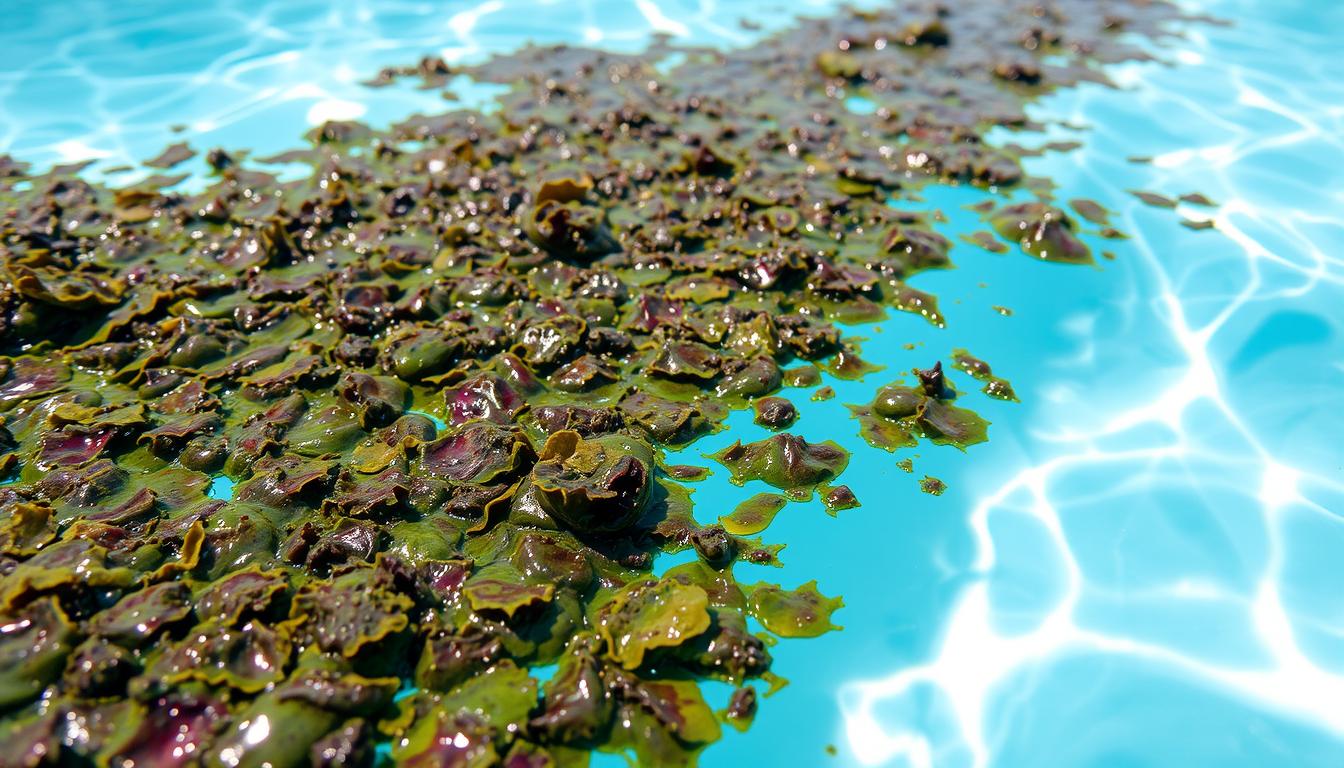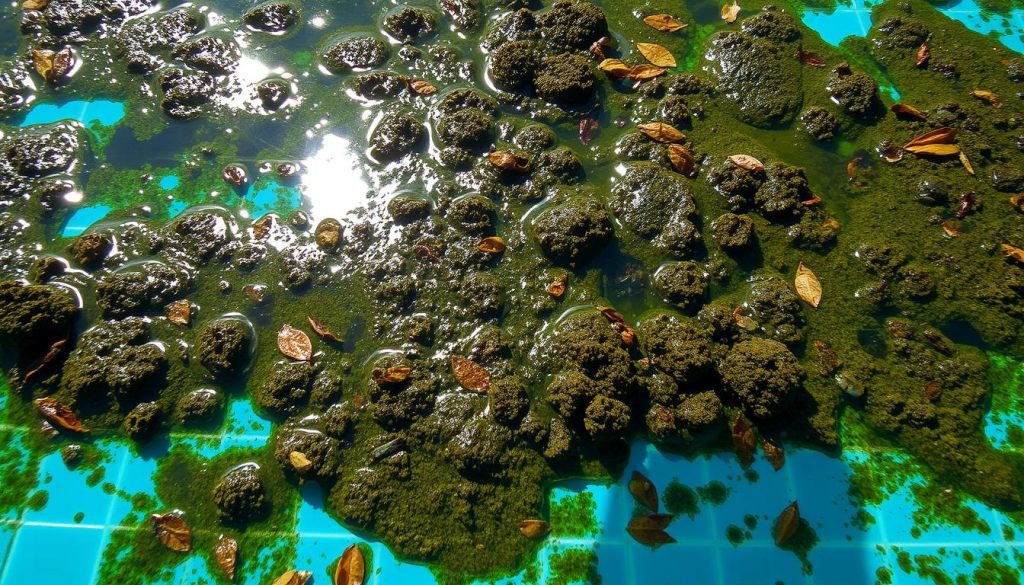
Algae can be a major headache for North Texas pool owners. Green algae is the most common type, spreading quickly in just 24 hours. Brown and pink algae can also cause problems in our pools. Knowing the signs of dead algae is key to keeping your pool clean and inviting.
Dead algae can change your pool’s look and water quality. The once bright green, brown, or pink colors turn into a murky mess. Let’s explore the signs of dead algae in your pool.
We’ll look at cloudy water, discolored surfaces, and strange smells. This knowledge will help you spot and fix this common pool issue quickly.
Signs of Dead Algae in Your Pool
Recognizing dead algae in your pool is crucial. Early detection allows quick action to restore clean water. Let’s explore key indicators of dead algae presence.
Cloudy or Milky Pool Water
Dead algae often cause cloudy or milky water. Decomposing particles stay suspended, creating a hazy look. This cloudiness varies based on infestation severity and decomposition stage.
A sudden change in water clarity after algae treatment likely indicates dead algae. Quick action is needed to address this issue.
Discolored Pool Surfaces
Dead algae leave slimy deposits on pool walls, floors, and steps. These appear as dark, greenish, or brownish stains resistant to regular brushing.
Such discolored areas show settled dead algae clinging to surfaces. Targeted cleaning is necessary to fully remove them.
| Type of Algae | Appearance | Chlorine Resistance |
|---|---|---|
| Green Algae | Cloudy green water | Low |
| Yellow (Mustard) Algae | Yellow or mustard-colored spots on surfaces | Moderate |
| Black Algae | Black dots on surfaces, deep-rooted | High |
Foul Odors Emanating from the Pool
Decomposing algae release unpleasant smells. These can be musty, earthy, or sewage-like, depending on algae type and die-off extent.
Strong, offensive odors with cloudy water or discolored surfaces indicate dead algae. Immediate attention is required to address this issue.
The key to maintaining a clean and healthy pool is to stay vigilant and address any signs of algae growth or die-off promptly. Regular testing, balanced water chemistry, and proper circulation are essential for preventing algae from taking hold in the first place.
Knowing these signs helps you act quickly to restore your pool. Next, we’ll explore what dead algae look like visually.
This knowledge aids in effective treatment and prevention. Stay alert to keep your pool pristine and enjoyable.
What Does Dead Algae Look Like
Dead algae in pools cause noticeable changes in water quality and appearance. They leave clear signs that demand quick action. Knowing these signs helps identify and address the problem early.

Slimy, Decomposing Algal Mats
Dead algae form slimy mats on pool surfaces. These appear on walls, floors, and steps, creating an unsightly layer. The mats feel sticky and may smell bad.
Their texture varies based on the algae type. As they break down, they release a foul odor.
Discolored Water with Floating Debris
Decomposing algae change pool water color and clarity. They release pigments and particles, causing discoloration. The water may turn green, brown, or murky.
Dead algae particles and organic matter float on the surface. This creates an unappealing and unhygienic environment.
Reduced Water Clarity and Visibility
Dead algae significantly decrease water clarity and visibility. As they break down, particles cloud the water. This makes it hard to see the pool bottom clearly.
Cloudy water indicates poor quality. It needs quick treatment to remove dead algae and restore clarity.
It’s crucial to be vigilant about the signs of dead algae in our pools. By recognizing the slimy algal mat texture, discolored water, and reduced visibility, we can take swift action to address the issue and prevent further deterioration of the pool’s condition.
Dead algae can release toxic compounds into pool water. This makes swimming unsafe. Watch for skin irritation, breathing issues, and stomach problems in swimmers.
If you suspect dead algae, test and treat the water quickly. This ensures safety for all pool users.
Treating and Preventing Dead Algae
To treat algae die-off, test pool water chemistry first. Balance pH between 7.2 and 7.8, keeping chlorine at 1-3 ppm. Shock the pool with high chlorine doses following manufacturer instructions.
Brush pool surfaces vigorously and vacuum dead algae. Run the filtration system continuously to aid removal. For stubborn cases like black algae, use strong algaecide.
Draining and acid-washing the pool may be necessary in extreme situations. Regular maintenance prevents algal blooms. Test and adjust water chemistry weekly.
Ensure proper filtration by cleaning and replacing filters regularly. Clean cartridge filters every 1-2 years. Replace sand in sand filters every 3-5 years.
Brush and vacuum the pool weekly. Use algaecide for extra protection. Install a solar pool ionizer to kill organic material naturally.
Inspect pools regularly for early signs of algae growth. Plant algaecidal plants around the pool to deter growth. These strategies keep pools clean and enjoyable.







